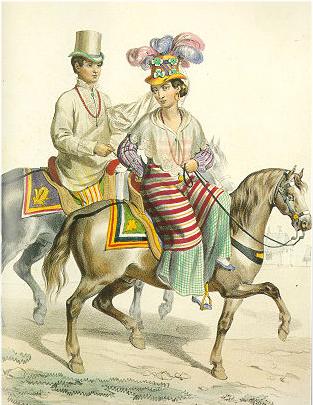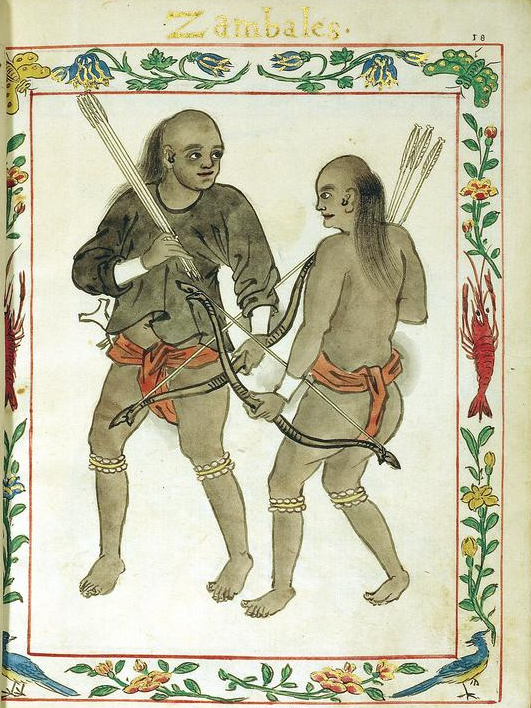|
Bahag (garment)
Bahag is a loincloth that was commonly used by men throughout the pre-colonial Philippines. They were either made from barkcloth or from hand- woven textiles. Before the colonial period, bahag were a common garment for commoners and the serf class (the ''alipin'' caste). Bahag survives in some indigenous tribes of the Philippines today - most notably the Cordillerans in Northern Luzon. Description The specific way to wear it involves first pulling the long piece of cloth (usually around ) in between the legs and covering the genitals, with a longer back part. The back part is then twisted across the right leg and across the waist in an anti-clockwise direction. It goes under the flap of the front part and across the left leg. It is twisted back across the back loop above the buttocks. The result resembles two rectangles of cloth hanging in front of and behind the waist, with a loop around the legs resembling a belt. The design of the weave is often unique to the tribe of the p ... [...More Info...] [...Related Items...] OR: [Wikipedia] [Google] [Baidu] |
Visayans
Visayans (Visayan: ''mga Bisaya''; ) or Visayan people are a Philippine ethnolinguistic group or metaethnicity native to the Visayas, the southernmost islands of Luzon and a significant portion of Mindanao. When taken as a single ethnic group, they are both the most numerous in the entire country at around 33.5 million, as well as the most geographically widespread. The Visayans broadly share a maritime culture with strong Roman Catholic traditions integrated into a precolonial indigenous core through centuries of interaction and migration mainly across the Visayan, Sibuyan, Camotes, Bohol and Sulu seas. In more inland or otherwise secluded areas, ancient animistic-polytheistic beliefs and traditions either were reinterpreted within a Roman Catholic framework or syncretized with the new religion. Visayans are generally speakers of one or more of the Bisayan languages, the most widely spoken being Cebuano, followed by Hiligaynon (Ilonggo) and Waray-Waray. Terminology '' K ... [...More Info...] [...Related Items...] OR: [Wikipedia] [Google] [Baidu] |
Tapis (Philippine Clothing)
Tapis across various cultures in the Philippines may generally refer to a single, rectangular piece of cloth one wraps around oneself as clothing, but is also the term for a colorful, hand-woven wraparound skirt common in the pre-colonial period, and which is still used today as part of the María Clara gown and by culturally conservative tribes. The tapis worn by the Cordilleran women of Northern Luzon, known locally as the ''alampay'', are the most prominent surviving example. It is worn by wrapping the cloth around one's waist and holding the ends together by means of a tightly tied sash. It generally reaches down to the knees. The woven pattern of a tapis describes the culture and temperament of the wearer's tribe. Broader usage (verb) Another use of the term, as a verb, simply means to wrap a piece of cloth around one's body to cover it up. A person who does so is said to be ('putting on a tapis'). This usage of the term does not require that the piece of cloth be a ... [...More Info...] [...Related Items...] OR: [Wikipedia] [Google] [Baidu] |
Boxer Codex
The ''Boxer Codex'' is a late sixteenth century Spanish manuscript that was produced in the Philippines. The document contains seventy-five colored illustrations of the peoples of China, the Philippines, Java, the Moluccas, the Ladrones, and Siam. About 270 pages of Spanish text describe these places, their inhabitants and customs. An additional eighty-eight smaller drawings show mythological deities and demons, and both real and mythological birds and animals copied from popular Chinese texts and books in circulation at the time. The eminent historian, Charles Ralph Boxer, purchased the manuscript in 1947 from the collection of Lord Ilchester in London. Boxer recognized the importance of what he called the "Manila Manuscript" and published a paper in 1950 with a detailed description of the codex. He made the manuscript freely available to other researchers for study and it became known as the "Boxer Codex" in recognition of its owner. Eventually Boxer sold the codex to Indiana U ... [...More Info...] [...Related Items...] OR: [Wikipedia] [Google] [Baidu] |
Sambal People
The Sambal people are a Filipino ethnolinguistic group living primarily in the province of Zambales and the Pangasinense municipalities of Bolinao and Anda. The term may also refer to the general inhabitants of Zambales. In 1950s, hundreds of Sambal from the northern municipalities of Zambales migrated to and established a settlement in Quezon, Palawan; this settlement was named Panitian. The residents call themselves ''Palawenyong Sambal'' (Spanish: ''zambales palaweños'') or simply ''Sambal''. History The Sambal are the original Austronesian inhabitants of the province of Zambales in the Philippines. They speak mainly Sambal and Botolan, as well as Kapampangan, Tagalog, Ilocano, Bolinao, and Pangasinense. The Sambalic languages are most closely related to the Kapampangan language and an archaic form of Tagalog still spoken in Tanay in the province of Rizal. This has been interpreted to mean that the Sambal originated from that area, later being displaced by migrating ... [...More Info...] [...Related Items...] OR: [Wikipedia] [Google] [Baidu] |
Bontoc People
The Bontoc (or Bontok) ethnolinguistic group can be found in the central and eastern portions of Mountain Province, in the Philippines. Although some Bontocs of Natonin and Paracelis identify themselves as Balangaos, Gaddangs or Kalingas, the term "Bontoc" is used by linguists and anthropologists to distinguish speakers of the Bontoc language from neighboring ethnolinguistic groups. They formerly practiced head-hunting and had distinctive body tattoos. Geography The Bontoc live in a mountainous territory, particularly close to the Chico River and its tributaries. Mineral resources (gold, copper, limestone, gypsum) can be found in the mountain areas. Gold, in particular, has been traditionally extracted from the Bontoc municipality. The Chico River provides sand, gravel, and white clay, while the forests of Barlig and Sadanga within the area have rattan, bamboo and pine trees. They are the second largest group in the Mountain Province. Social organization The Bontoc social s ... [...More Info...] [...Related Items...] OR: [Wikipedia] [Google] [Baidu] |
Igorot People
The indigenous peoples of the Cordillera Mountain Range of northern Luzon, Philippines are often referred to using the exonym Igorot people, or more recently, as the Cordilleran peoples. There are nine main ethnolinguistic groups whose domains are in the Cordillera Mountain Range, altogether numbering about 1.5 million people in the early 21st century. Their languages belong to the northern Luzon subgroup of Philippine languages, which in turn belongs to the Austronesian (Malayo-Polynesian) family. These ethnic groups keep or have kept until recently their traditional religion and way of life. Some live in the tropical forests of the foothills, but most live in rugged grassland and pine forest zones higher up. Etymology From the root word ''golot'', which means "mountain," ''Igolot'' means "people from the mountains", a reference to any of various ethnic groups in the mountains of northern Luzon. During the Spanish colonial era, the term was variously recorded as ''Igolot'', ... [...More Info...] [...Related Items...] OR: [Wikipedia] [Google] [Baidu] |
Tagalog Language
Tagalog (, ; ; '' Baybayin'': ) is an Austronesian language spoken as a first language by the ethnic Tagalog people, who make up a quarter of the population of the Philippines, and as a second language by the majority. Its standardized form, officially named ''Filipino'', is the national language of the Philippines, and is one of two official languages, alongside English. Tagalog is closely related to other Philippine languages, such as the Bikol languages, Ilocano, the Bisayan languages, Kapampangan, and Pangasinan, and more distantly to other Austronesian languages, such as the Formosan languages of Taiwan, Indonesian, Malay, Hawaiian, Māori, and Malagasy. Classification Tagalog is a Central Philippine language within the Austronesian language family. Being Malayo-Polynesian, it is related to other Austronesian languages, such as Malagasy, Javanese, Indonesian, Malay, Tetum (of Timor), and Yami (of Taiwan). It is closely related to the languages spoken in the Bi ... [...More Info...] [...Related Items...] OR: [Wikipedia] [Google] [Baidu] |
Visayan Tattoos
Visayans (Visayan: ''mga Bisaya''; ) or Visayan people are a Philippine ethnolinguistic group or metaethnicity native to the Visayas, the southernmost islands of Luzon and a significant portion of Mindanao. When taken as a single ethnic group, they are both the most numerous in the entire country at around 33.5 million, as well as the most geographically widespread. The Visayans broadly share a maritime culture with strong Roman Catholic traditions integrated into a precolonial indigenous core through centuries of interaction and migration mainly across the Visayan, Sibuyan, Camotes, Bohol and Sulu seas. In more inland or otherwise secluded areas, ancient animistic-polytheistic beliefs and traditions either were reinterpreted within a Roman Catholic framework or syncretized with the new religion. Visayans are generally speakers of one or more of the Bisayan languages, the most widely spoken being Cebuano, followed by Hiligaynon (Ilonggo) and Waray-Waray. Terminology '' ... [...More Info...] [...Related Items...] OR: [Wikipedia] [Google] [Baidu] |
Luzon
Luzon (; ) is the largest and most populous island in the Philippines. Located in the northern portion of the Philippines archipelago, it is the economic and political center of the nation, being home to the country's capital city, Manila, as well as Quezon City, the country's most populous city. With a population of 64 million , it contains 52.5% of the country's total population and is the fourth most populous island in the world. It is the 15th largest island in the world by land area. ''Luzon'' may also refer to one of the three primary island groups in the country. In this usage, it includes the Luzon mainland, the Batanes and Babuyan groups of islands to the north, Polillo Islands to the east, and the outlying islands of Catanduanes, Marinduque and Mindoro, among others, to the south. The islands of Masbate, Palawan and Romblon are also included, although these three are sometimes grouped with another of the island groups, the Visayas. Etymology The name ''Luz ... [...More Info...] [...Related Items...] OR: [Wikipedia] [Google] [Baidu] |
Datu And Binokot (Principalia) - Philippines (c
''Datu'' is a title which denotes the rulers (variously described in historical accounts as chiefs, sovereign princes, and monarchs) of numerous indigenous peoples throughout the Philippine archipelago. The title is still used today, especially in Mindanao, Sulu and Palawan, but it was used much more extensively in early Philippine history, particularly in the regions of Central and Southern Luzon, the Visayas and Mindanao. It is a cognate of the title ''ratu'' in several other Austronesian languages. Overview In early Philippine history, datus and a small group of their close relatives formed the "apex stratum" of the traditional three-tier social hierarchy of lowland Philippine societies. Only a member of this birthright aristocracy (called "''maginoo''", "''nobleza''", "''maharlika''", or "''timagua''" by various early chroniclers) could become a datu; members of this elite could hope to become a datu by demonstrating prowess in war or exceptional leadership. In large co ... [...More Info...] [...Related Items...] OR: [Wikipedia] [Google] [Baidu] |
Igorot
The indigenous peoples of the Cordillera Mountain Range of northern Luzon, Philippines are often referred to using the exonym Igorot people, or more recently, as the Cordilleran peoples. There are nine main ethnolinguistic groups whose domains are in the Cordillera Mountain Range, altogether numbering about 1.5 million people in the early 21st century. Their languages belong to the northern Luzon subgroup of Philippine languages, which in turn belongs to the Austronesian (Malayo-Polynesian) family. These ethnic groups keep or have kept until recently their traditional religion and way of life. Some live in the tropical forests of the foothills, but most live in rugged grassland and pine forest zones higher up. Etymology From the root word ''golot'', which means "mountain," ''Igolot'' means "people from the mountains", a reference to any of various ethnic groups in the mountains of northern Luzon. During the Spanish colonial era, the term was variously recorded as ''Igolot'', ... [...More Info...] [...Related Items...] OR: [Wikipedia] [Google] [Baidu] |







